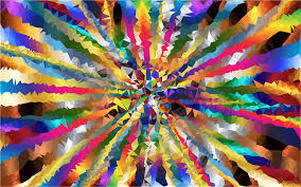
A second picture of unity, drawn from scripture and human history, is that of the body. If, it is argued, the body, whether of society as a whole, or of the individual, is not controlled, and even heavily policed, in all its parts, then everything will be corrupted. This has to be part of the irrational fears behind opposition to marriage equality and homophobia and transphobia more generally. Even though the result may be great pain and violence, it is not possible, some feel, to agree to disagree about the body.
A third picture of unity, again drawn from scripture and history, is the idea of a people. To live together as one human community, it has been argued, we need to know ourselves as bound together by one set of stories, customs, and language. This kind of thinking lies behind resurgent nationalism, racism, and oppression of minorities and refugees in many places. Even though this learns nothing from history, it is not possible, some feel, to agree to disagree about what constitutes a people.
So, in this Week of Prayer for Christian Unity, and Reconciliation Week, what is our picture of unity? Do we assent to such interpretations, and their consequences? If not, how do we agree to disagree? What pictures of unity with diversity might we paint and live out? These things are not easy to work out, as I know from working for the best part of 8 years in the offices of the National Council of Churches and New South Wales Ecumenical Council. Yet, as we reflect together on today’s lectionary readings, let me offer three images which have struck me as helpful this week.
The first image, to balance and redeem that of the holy place, is that of the bee. For the worker bee has been a symbol of Manchester for at least 200 years and bees have consequently been prolific in responses and messages of support for the Manchester bomb victims this last week. The worker bee, in Manchester’s history, represents that city’s strengths: its amazing cooperative, resilient and communitarian traditions. A holy place is only that, we may say, when such values are present. All the finest holy buildings in the world amount to nothing if the people within and around them do not display such characteristics. They may not have to agree on everything, but how they live and work together in the face of challenge is what matters. This is part of the message of our reading from I Peter, isn’t it? This is not at all concerned with the church building as a holy place, but with the people of God as a holy being, in whatever place or circumstances they find themselves. ‘Like a roaring lion’, says the writer, your adversary the devil prowls around, looking for someone to devour. Resist him, steadfast in your faith, for you know that your brothers and sisters in all the world are undergoing the same kinds of suffering.’ It is a message of encouragement to shared humility and solidarity. This is at the heart of true unity and reconciliation.
A second image, to balance and redeem that of the body, is that of the rainbow. Now I am not really talking about the rainbow flag as such, though it is such a lively symbol of new life and energy. For the rainbow of course is so much bigger than that as an image and its different colours are so many more. The rainbow has empowered human beings down the centuries, as both a natural and a scriptural icon and as a lived expression of unity with amazing diversity. We saw this, for example, in the grace-filled birth of South Africa, as a self-identified ‘rainbow nation’, at the end of apartheid. It reminds us that a body is only really healthy when it treasures all its parts and members and enables them to grow and move in life-giving complementary ways. A body does not even need to be perfect, whatever that might mean, so long as it works together for good: or, as our Gospel reading puts it today, for glory. We may, as Christians, and as people together with others in our wider world, be imperfect. Yet we can share in God’s glory, as we share in Jesus’ prayer and reconciling body.
A third image, to balance and redeem that of a holy people, is that of the campfire. For a campfire is such a powerful symbol of dynamic unity and of inviting, inclusive community. Around a campfire space can be offered for everyone, all kinds of different foods can be shared, and all kinds of stories told and celebrated. At its heart is no single idea, person, or culture, but rather one source of renewing life, warmth, energy and difference No wonder the campfire is a treasured part of Aboriginal culture and part of our First Peoples gift and invitation to us all. Again, this emphasis on a vibrant togetherness through the sharing of our differences is also offered to us in our readings today, not least the picture of the apostolic Christian community which we find in the Acts of the Apostles. Here we do not see defensive groups and individuals suspicious of one another and asserting their own requirements. Instead we find a movement of love, open to one another’s differences, appreciative of such diversity as valuable and essential gifts, and energetically engaged in relationships with others of all kinds of ideas and culture: agreeing to disagree on whatever does not really matter, drawing life and strength from the fire of God’s compassion.
In the name and in the camp of the Holy Trinity, who blazes across eternity, shines out in incandescent diversity, and works among us, and with us, as a humble bee. Amen.
Jo Inkpin, for Easter 7A, 28 May 2017, Chapel of the Holy Spirit Milton
 RSS Feed
RSS Feed